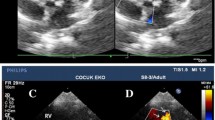Abstract
A left ventricular angiocardiogram for evaluation of the mitral valve in patients with uncomplicated secundum type atrial septal defect has been proposed in a recent paper by Victorica et al. (1974). These authors observed 8 children with a ballooning mitral valve and ASD II. They stressed the necessity of performing a left ventricular angiocardiogram in every patient with ASD II. To challange their proposal, the angiocardiograms of 78 children with secundum type ASD were reviewed. Of these 89 angios 34 were performed using the left ventricle (LV) as injection site while 55 times the injection was made in other parts of the heart, e.g. left atrium, pulm. art., right ventricle, right atrium. All 34 LV angios, but only 12 of the others allowed an evaluation of function and morphology of the mitral valve.
Of the 46 angiocardiograms 27 (58.7%) revealed an intact, normally closing and opening mitral valve. In the remaining 19 (41.3%) various grades of ballooning or mild prolapsing of one or two leaflets of the mitral valve could be detected. The “scallops” were minimal in 12, moderate in 4 and pronounced in 3 cases. A mild regurgitation was seen in 1 patient only. No patient had the pronounced ballooning observed by Victorica et al. On auscultation only 1 case had the apical murmur of mitral regurgitation. The ECG of our 19 “positive” cases did not show signs of left atrial or left ventricular hypertrophy. A left axis deviation was found in 1 patient.
During surgery no structural abnormality of the mitral valve was noted. Postoperative reevaluation of the mitral valve (including left ventricular contrast injection) in 10 cases revealed no changes of mitral valve appearance in 8, a decrease of the ballooning in one, and an increase in another patient.
It is concluded that prolapses of the mitral valve are seldom of such a degree as to cause dysfunction in children with secundum type ASD. The indications for performing a left ventricular injection of contrast material are the clinical signs of mitral valve regurgitation and/or left axis deviation in the ECG.
Zusammenfassung
Veröffentlichungen über den Prolaps der Mitralklappe beim Secundum-Vorhofseptumdefekt (ASD II) sind in letzter Zeit häufiger zu finden. Einige Autoren fordern bei der Diagnostik dieses Herzvitiums sogar immer ein linksventrikuläres Angiokardiogramm [11]. Von 89 Angiokardiogrammen, die bei 78 Kindern (1–13 Jahre alt) mit ASD II angefertigt wurden, war 34mal der linke Ventrikel der Injektionsort, und 55mal wurde das Kontrastmittel in andere Herzabschnitte injiziert: linker Vorhof, Pulmonalarterie, rechter Ventrikel, rechter Vorhof. Alle 34 LV-Angios, aber nur 12 der anderen, also insgesamt 46 Filme erlaubten eine Beurteilung von Funktion und Morphologie der Mitralklappe.
Von den 46 Angiokardiogrammen zeigten 27 (58,7%) eine intakte, normal sich öffnende und schließende Mitralklappe. Bei den übrigen 19 (41,3%) dagegen fanden sich verschiedene Grade eines Prolapses eines oder beider Mitralsegel. Die Vorwölbungen der Klappe in den linken Vorhof waren leicht bei 12 Fällen, mäßig bei 4 und ausgeprägt bei 3 Kindern. Nur 1 Patient zeigte eine leichte Mitralinsuffizienz, die auch ein apikales Geräusch verursachte. Keiner der 19 Patienten hatte im EKG Zeichen von linksatrialer oder linksventrikulärer Hypertrophie; eine linksgerichtete elektrische Herzachse fand sich nur einmal.
Intraoperative Untersuchung der Mitralklappe ergab keine Strukturveränderungen. Postoperative Linksangiokardiogramme bei 10 Kindern zeigten identische Veränderungen an der Mitralklappe bei 8, einen geringeren Prolaps und einen stärkeren als präoperativ bei jeweils 1 Patienten.
Bei Kindern mit ASD II werden durch den Prolaps der Mitralklappe nur selten Funktionstörungen dieser Klappe verursacht. Ein Linksangiokardiogramm erscheint nur indiziert, wenn klinische Zeichen der Mitralinsuffizienz oder eine Linksachse im EKG (Ausschluß eines Primum-defektes —ASD I) vorliegen.
Similar content being viewed by others
References
Betriu, A., Douglas Wigle, E., Felderhof, C. H., McLoughlin, M. J.: Prolapse of the posterior leaflet of the mitral valve associated with secundum atrial septal defect. Amer. J. Cardiol. 33, 126 (1974)
Demos, N. J., Franklin, J., Sabety, A., Yaduski, R., Timmes, J. J., Toruella, J. M.: Coexistence of mitral valve disease and atrial septal defect. J. thorac. cardiovase. Surg. 54, 278–284 (1967)
Hynes, M. K., Frye, R. L., Brandenburg, R. O., McGoon, D. C., Titus, J. L., Giuliani, E. R.: Atrial septal defect (secundum) associated with mitral regurgitation. Amer. J. Cardiol. 34, 333–338 (1974)
Jeresaty, R. M.: Atrial septal defect and myxomatous mitral valve prolapse. New Engl. J. Med. 290, 1088 (1974)
Lundström, N. R., Mortensson, W.: Ballonerande mitralisklaff som orsak till mitralis-insufficiens hos barn. Läkartidningen 69, 4391–4394 (1974)
Marshall, J., Warden, H. E.: Mitral valve disease complicated by left-to-right-shunt at atrial level. Circulation 29, 432–439 (1964)
McDonald, A., Harris, A., Jefferson, K., Marshall, J., McDonald, L.: Association of prolapse of the posterior cusp of the mitral valve and atrial septal defect. Brit. Heart J. 33, 383–387 (1971)
Moppert, J., Burckhardt, D., Follath, F., Schmitt, H. T.: Systolischer Prolaps (“Ballooning”) der Mitralklappe mit Vorhofseptumdefekt vom Sekundumtyp. Z. Kardiol. 64, 170–178 (1975)
Pocock, W. A., Barlow, J. B.: An association between the billowing posterior mitral leaflet syndrome and congenital heart disease particulary atrial septal defect. Amer. Heart J. 81, 720–722 (1971)
Sugg, W. L., Fox, M. L.: Congenital mitral insufficiency and atrial septal defect. Vasc. Surg. 1, 205–213 (1967)
Victorica, B. E., Elliot, L. P., Gessner, I. H.: Ostium secundum atrial septal defect associated with balloon mitral valve in children. Amer. J. Cardiol. 33, 669–673 (1974)
Author information
Authors and Affiliations
Additional information
Prof. Dr. K. H. Schäfer on his 65th birthday.
Rights and permissions
About this article
Cite this article
Keck, E.W., Henschel, W.G. & Gruhl, L. Mitral valve prolapse in children with secundum —Type atrial septal defect (ASD II). Eur J Pediatr 121, 89–97 (1976). https://doi.org/10.1007/BF00443064
Received:
Issue Date:
DOI: https://doi.org/10.1007/BF00443064




